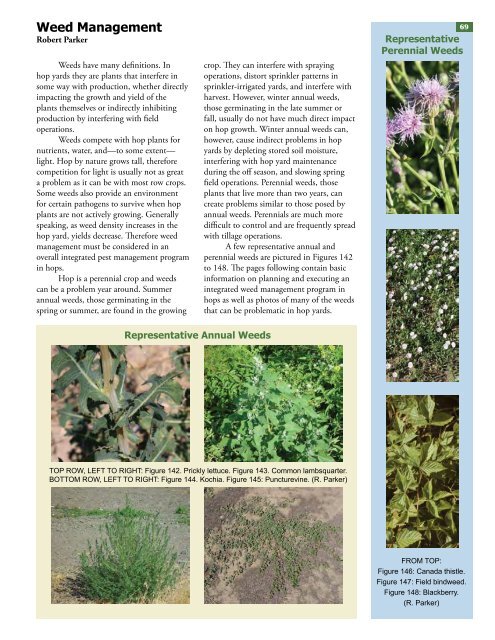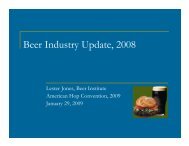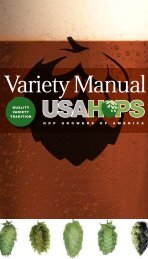Field Guide for Integrated Pest Management in Hops
Field Guide for Integrated Pest Management in Hops
Field Guide for Integrated Pest Management in Hops
Create successful ePaper yourself
Turn your PDF publications into a flip-book with our unique Google optimized e-Paper software.
Weed <strong>Management</strong>Robert ParkerWeeds have many def<strong>in</strong>itions. Inhop yards they are plants that <strong>in</strong>terfere <strong>in</strong>some way with production, whether directlyimpact<strong>in</strong>g the growth and yield of theplants themselves or <strong>in</strong>directly <strong>in</strong>hibit<strong>in</strong>gproduction by <strong>in</strong>terfer<strong>in</strong>g with fieldoperations.Weeds compete with hop plants <strong>for</strong>nutrients, water, and—to some extent—light. Hop by nature grows tall, there<strong>for</strong>ecompetition <strong>for</strong> light is usually not as greata problem as it can be with most row crops.Some weeds also provide an environment<strong>for</strong> certa<strong>in</strong> pathogens to survive when hopplants are not actively grow<strong>in</strong>g. Generallyspeak<strong>in</strong>g, as weed density <strong>in</strong>creases <strong>in</strong> thehop yard, yields decrease. There<strong>for</strong>e weedmanagement must be considered <strong>in</strong> anoverall <strong>in</strong>tegrated pest management program<strong>in</strong> hops.Hop is a perennial crop and weedscan be a problem year around. Summerannual weeds, those germ<strong>in</strong>at<strong>in</strong>g <strong>in</strong> thespr<strong>in</strong>g or summer, are found <strong>in</strong> the grow<strong>in</strong>gcrop. They can <strong>in</strong>terfere with spray<strong>in</strong>goperations, distort spr<strong>in</strong>kler patterns <strong>in</strong>spr<strong>in</strong>kler-irrigated yards, and <strong>in</strong>terfere withharvest. However, w<strong>in</strong>ter annual weeds,those germ<strong>in</strong>at<strong>in</strong>g <strong>in</strong> the late summer orfall, usually do not have much direct impacton hop growth. W<strong>in</strong>ter annual weeds can,however, cause <strong>in</strong>direct problems <strong>in</strong> hopyards by deplet<strong>in</strong>g stored soil moisture,<strong>in</strong>terfer<strong>in</strong>g with hop yard ma<strong>in</strong>tenancedur<strong>in</strong>g the off season, and slow<strong>in</strong>g spr<strong>in</strong>gfield operations. Perennial weeds, thoseplants that live more than two years, cancreate problems similar to those posed byannual weeds. Perennials are much moredifficult to control and are frequently spreadwith tillage operations.A few representative annual andperennial weeds are pictured <strong>in</strong> Figures 142to 148. The pages follow<strong>in</strong>g conta<strong>in</strong> basic<strong>in</strong><strong>for</strong>mation on plann<strong>in</strong>g and execut<strong>in</strong>g an<strong>in</strong>tegrated weed management program <strong>in</strong>hops as well as photos of many of the weedsthat can be problematic <strong>in</strong> hop yards.69RepresentativePerennial WeedsRepresentative Annual WeedsTOP ROW, LEFT TO RIGHT: Figure 142. Prickly lettuce. Figure 143. Common lambsquarter.BOTTOM ROW, LEFT TO RIGHT: Figure 144. Kochia. Figure 145: Puncturev<strong>in</strong>e. (R. Parker)FROM TOP:Figure 146: Canada thistle.Figure 147: <strong>Field</strong> b<strong>in</strong>dweed.Figure 148: Blackberry.(R. Parker)








